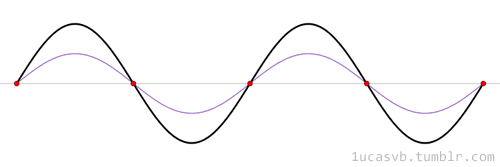
Unit 10 Overview: Mechanical Waves and Sound
1 min read•june 11, 2020
Peter Apps
Peter Apps
Unit 10 shifts away from the electrical focus of Units 8 & 9 and transitions back to discussing topics like energy (Unit 4), period (Unit 6) and motion (Unit 1). This time the focus is on describing , such as waves in slinkies, ropes, and water, as well as sound waves. Additionally we will apply our knowledge of waves to explain how musical instruments generate specific tones. This unit covers approximately 12-16% of the AP exam and will typically take 11-14 45 minute class periods to cover.
Applicable Big Ideas
Big Idea #6: Waves Waves can transfer energy and momentum from one location to another without the permanent transfer of mass and serve as a mathematical model for the description of other phenomena

Image courtesy of Giphy.
Key Concepts 🔑
Period (T)
Frequency (f)
Velocity (v)
Wavelength (𝜆)
Key Equations 🗝

🎥Watch: AP Physics 1 - Unit 10 Streams
Key Terms to Review (9)
Amplitude
: The amplitude represents the maximum displacement from equilibrium in a periodic motion.Antinode
: An antinode is a point or region in a standing wave where the amplitude of the wave is at its maximum.Frequency (f)
: Frequency refers to the number of cycles or oscillations that occur in one second.Interference
: Interference occurs when two or more waves overlap and combine, resulting in either constructive interference (amplification) or destructive interference (cancellation).Mechanical Waves
: Mechanical waves are waves that require a medium (such as air, water, or solids) to travel through. They transfer energy by causing particles in the medium to vibrate.Node
: A node is a point or region in a standing wave where the amplitude of the wave is always zero.Period (T)
: The period refers to the time it takes for one complete cycle of a periodic motion.Velocity (v)
: Velocity measures how fast an object's position changes with respect to time. It includes both speed and direction.Wavelength (𝜆)
: Wavelength represents the distance between two consecutive points on a wave that are in phase with each other. It is usually measured from crest to crest or trough to trough.Unit 10 Overview: Mechanical Waves and Sound
1 min read•june 11, 2020
Peter Apps
Peter Apps
Unit 10 shifts away from the electrical focus of Units 8 & 9 and transitions back to discussing topics like energy (Unit 4), period (Unit 6) and motion (Unit 1). This time the focus is on describing , such as waves in slinkies, ropes, and water, as well as sound waves. Additionally we will apply our knowledge of waves to explain how musical instruments generate specific tones. This unit covers approximately 12-16% of the AP exam and will typically take 11-14 45 minute class periods to cover.
Applicable Big Ideas
Big Idea #6: Waves Waves can transfer energy and momentum from one location to another without the permanent transfer of mass and serve as a mathematical model for the description of other phenomena

Image courtesy of Giphy.
Key Concepts 🔑
Period (T)
Frequency (f)
Velocity (v)
Wavelength (𝜆)
Key Equations 🗝

🎥Watch: AP Physics 1 - Unit 10 Streams
Key Terms to Review (9)
Amplitude
: The amplitude represents the maximum displacement from equilibrium in a periodic motion.Antinode
: An antinode is a point or region in a standing wave where the amplitude of the wave is at its maximum.Frequency (f)
: Frequency refers to the number of cycles or oscillations that occur in one second.Interference
: Interference occurs when two or more waves overlap and combine, resulting in either constructive interference (amplification) or destructive interference (cancellation).Mechanical Waves
: Mechanical waves are waves that require a medium (such as air, water, or solids) to travel through. They transfer energy by causing particles in the medium to vibrate.Node
: A node is a point or region in a standing wave where the amplitude of the wave is always zero.Period (T)
: The period refers to the time it takes for one complete cycle of a periodic motion.Velocity (v)
: Velocity measures how fast an object's position changes with respect to time. It includes both speed and direction.Wavelength (𝜆)
: Wavelength represents the distance between two consecutive points on a wave that are in phase with each other. It is usually measured from crest to crest or trough to trough.
Resources
© 2024 Fiveable Inc. All rights reserved.
AP® and SAT® are trademarks registered by the College Board, which is not affiliated with, and does not endorse this website.